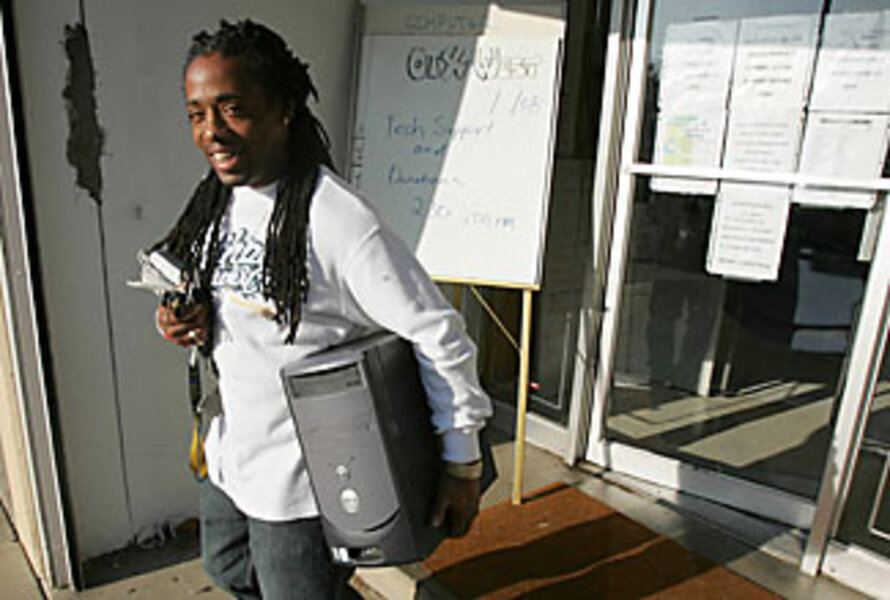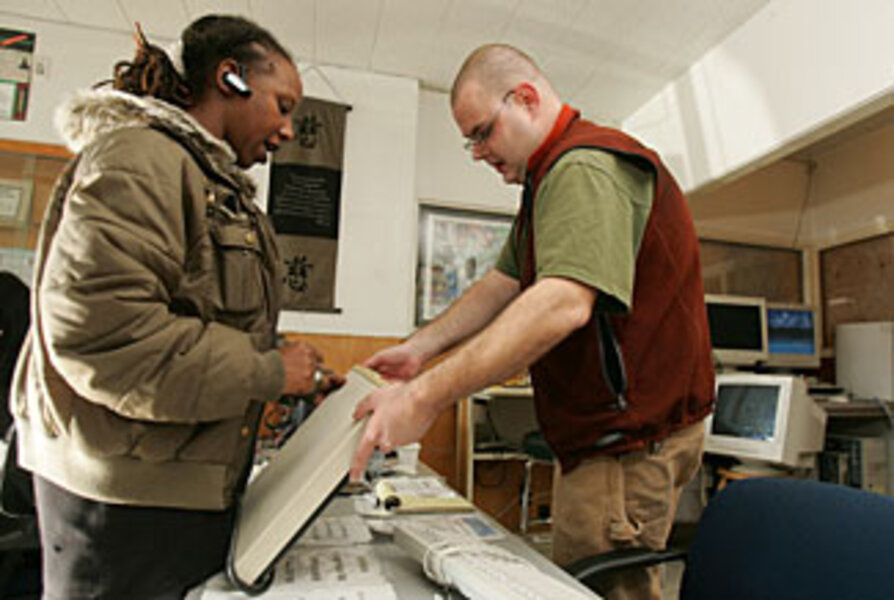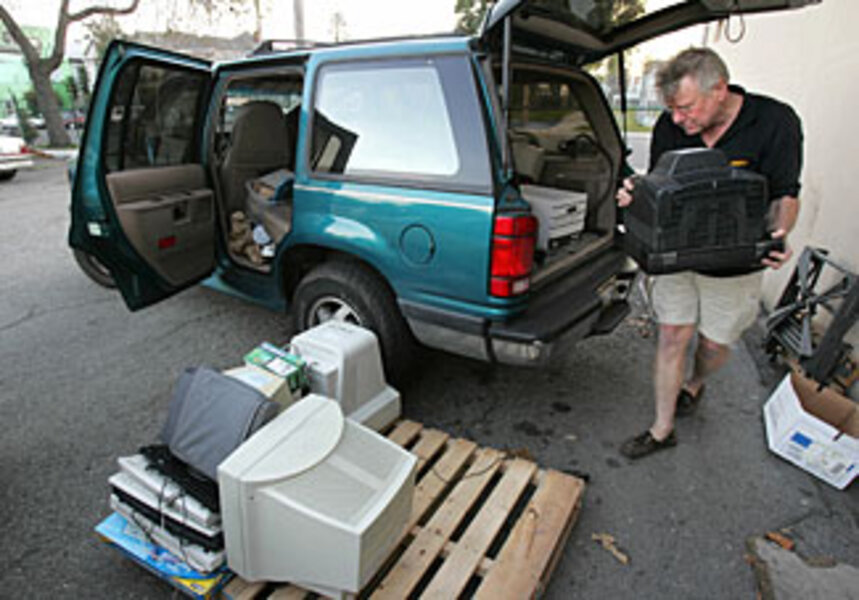Good times for repair shops and secondhand stores
Loading...
| Alameda, Calif.
Americans are rediscovering the fusty fix-it shops and unassuming secondhand stores on their local Main Streets. These businesses, once the left-behind nooks of gentrifying downtowns, are busier than ever amid an economic slump that's emptied out neighboring bistros, boutiques, and day spas.
On a Saturday afternoon in downtown Alameda, Calif., Gabe Morgan waits in a line of customers at The Watch Hospital to get a timepiece fixed. The economic downturn has made him think more about repairing than buying new.
"For the first time in I don't remember how long, I got some shoes repaired," says Mr. Morgan. He dug out three pairs from his closet for resoling. "I wanted to save some money."
For decades, repair and reuse have been fading ethics, upheld mainly by environmentalists and people on the economic margins. As hard times drive these values back into the mainstream, champions of reuse caution that some government policies and business practices threaten to set back the movement.
"We were a mend-and-make-do society, and we have completely changed. We don't fix anything anymore. We use, throw away, and buy more," says Bruce Buckelew, a former IBM engineer who has repaired more than 30,000 computers and put them into public schools, nonprofits, and low-income households in Oakland, Calif. "The worse the stock market gets and the bleaker the job market, the better for reuse, actually."
Some early signs:
•Sales increased year-over-year this fall at 74 percent of secondhand stores surveyed by the National Association of Resale and Thrift Shops (NARTS). Ninety percent of the stores saw an increase in new customers.
•Business is "booming" at the estimated 7,000 shoe repair shops in the US, according to John McLoughlin, president of the Shoe Service Institute of America. "At some shops, you have to wait three or four weeks, which ordinarily is just unheard-of," he says.
•Shops around California's Bay Area – from vacuum, bicycle, and watch repair to cobblers and secondhand clothing stores – report sales growing or holding firm in one of the toughest times for retailers in recent memory.
"This week has been really good," says Anne Hartford, owner of Maribel, an Oakland store selling used designer clothes. She hasn't seen a drop in sales from the previous year, while two of her friends who run other businesses have been forced to close shop recently.
Though many thrift stores and secondhand shops are thriving, they nonetheless operate on the economic margins. That can be a difficult place to be when it comes to regulation. The federal Consumer Product Safety Improvement Act that goes into effect Feb. 10, for instance, requires businesses that sell children's products to prove that their wares meet safety standards for lead content. Initially, that included resale, thrift, and consignment stores, who objected on grounds that they could not afford to test all the items from all the manufacturers whose products landed on their shelves.
The stores would have had "to clean out their inventory [of children's products] because they have no way of proving that it's below the lead standard," says Adele Meyer, NARTS executive director.
Last week, vociferous outcry from thrift stores prompted federal regulators to reconsider. The shops no longer will be required to certify that goods for children younger than 12 meet the lead standard, but neither are they permitted to sell items in violation – leaving them in a murky gray legal zone.
It's one of many ways in which policy and market oversights vex this less-visible segment of the economy. Another looming problem: replaceable parts.
"What's different from the last time we had a recession is that a lot of the products are not repairable because parts are not made for them – they are considered disposable," says Vicky Evans, owner of Phil's Electric Center in San Francisco, which fixes everything from vacuums to countertop appliances.
The imminent national switchover to digital television represents another challenge for reuse and could send a lot of televisions to the landfill. While the Federal Communications Commission is offering coupons to offset the cost of converter boxes for older televisions, the program is poorly designed for low-income people who need the coupons most, says Mr. Buckelew. Mailing away for coupons isn't convenient and the online application is not accessible for everyone, he says. The government has already run out of funding for additional coupons, and few stores are selling cheap converters, he adds.
He has overcome past obstacles to electronics reuse to build a computer repair and reuse nonprofit called Oakland Technology Exchange West. He takes old computers off the hands of businesses, fixes them up, and gives them to students and needy families or sells them to schools and nonprofits. Many of these machines, about eight years old and widely considered obsolete, can be souped up to perform well even compared with new computers, says Buckelew.
Computers typically operate more slowly after a few years because they become bogged down with files. Buckelew's team cleans off all the software and installs older versions of Windows that Microsoft now makes available to certified resellers. Add some additional open-source programs and some additional memory, and the computer can meet the needs of most users.
Buckelew sweetens the deal by including classes on how to use the computer and free repairs for life.
"Computers are expensive and anything that helps my family with furthering their education is really important," says Sheri Stewart, a recipient of one of Buckelew's computers. The classes, though, were the big draw: "If you bought in a store you don't know how to set it up, the dos and dont's, nothing."
Buckelew sees computer reuse as an way to ameliorate a number of social problems, including pollution and poverty.
"There's still a digital divide [between socioeconomic classes]. And there's this e-waste stream where people are throwing out these computers that are perfectly good. Talk about two problems with one solution," he says.
Before the economic downturn started mainstreaming the reuse trend, the reuse market tended to attract people who saw it as conserving both their money and the planet's resources, says John Lastovicka, a frugality expert at Arizona State University in Tempe. People who voluntarily try to reuse items often view the effort as an enjoyable challenge, his research has found.
"Unfortunately, part of this is probably a lost art. The 'greatest generation' that lived through the Depression, this was part of their day-to-day behavior," says Professor Lastovicha. Far fewer people have carried on that tradition because it's time-consuming and can be something that people laugh at. "It can be a tough sell, unless you have to do it – which is what's happened."







